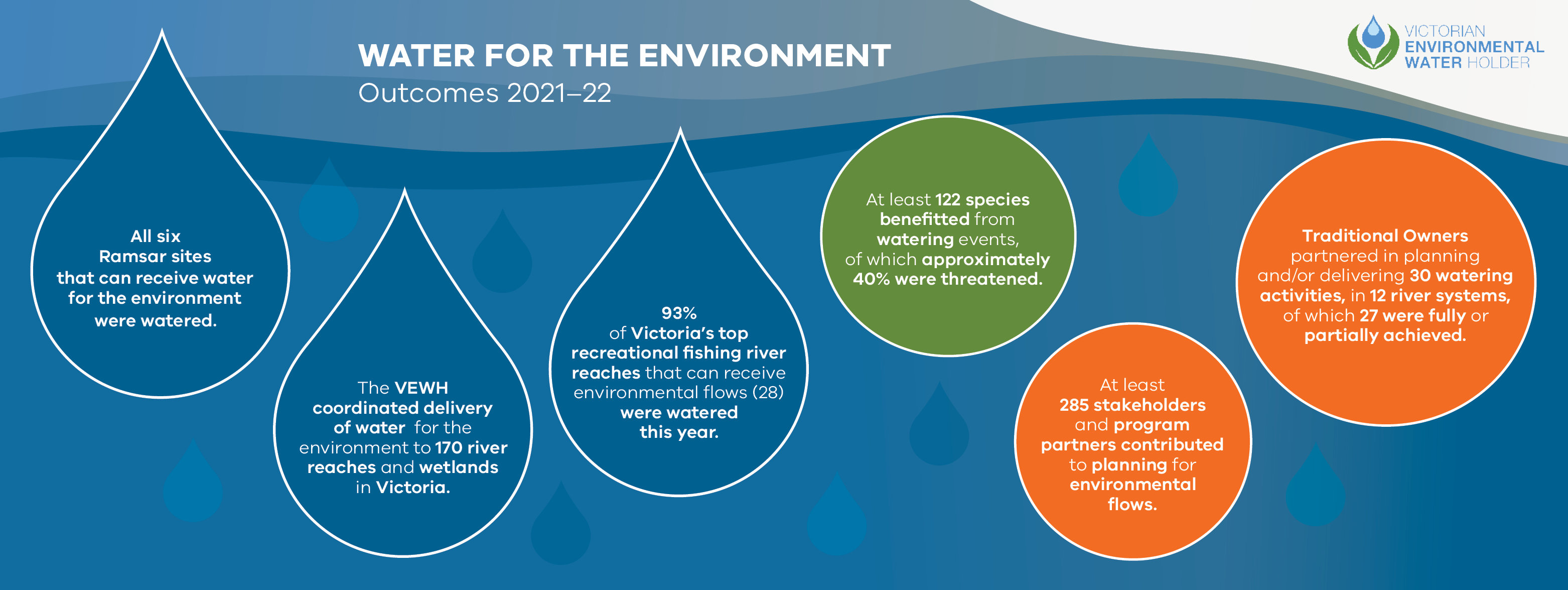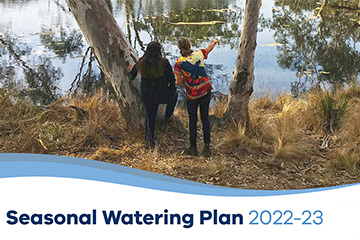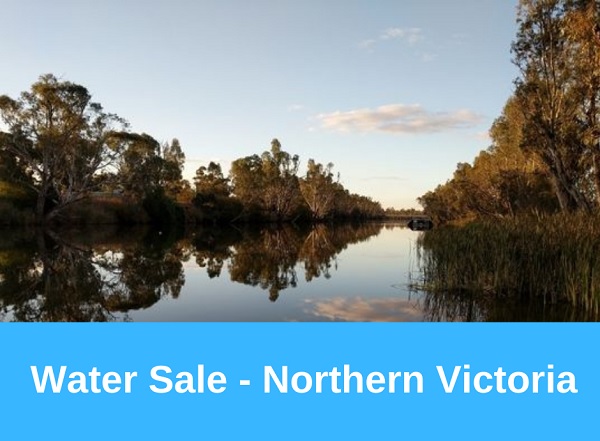Reflections: Water for the Environment in Victoria, 2021-22
21 December 2022
Reflections is an opportunity for the VEWH and partners to highlight the annual achievements and ongoing environmental outcomes of delivering water for the environment, across the Victorian environmental watering program.
Click here to download a PDF version of Reflections 2021-22 ![]() [PDF File - 1.8 MB]
[PDF File - 1.8 MB]
Water held in storages for the environment plays a key role in supporting our rivers and wetlands, since natural flows have been changed through the introduction of dams, weirs, channels and other infrastructure in many river systems to meet important human needs.
Water for the environment looks to provide outcomes such as: cueing fish migration and breeding; improving water quality; improving the condition of established floodplain trees; triggering the growth of wetland plants and providing feeding and nesting habitats for waterbirds.
There are also significant benefits to people when waterways are healthy – such as through increased tourism, recreation, economic prosperity and wellbeing.
Varying conditions required the program to adapt to different needs
The Seasonal Watering Plan 2021 -22 outlined how proposed deliveries of water for the environment in each system would be adapted in response to dry, average or wet climatic conditions during the year.
Climatic conditions varied considerably across Victoria between 1 July 2021 and 30 June 2022.
Gippsland was very wet and had widespread floods, northern and central parts of Victoria were slightly wetter than average, but western Victoria remained dry.
Each of these conditions presented a different suite of challenges and opportunities for partners in the Victorian environmental watering program, collaborating to make the best use of available water in rivers and wetlands across the state.
Our Reflections for 2021-22
This year, we reflect on the environmental watering approach undertaken in different parts of Victoria during 2021-22.
We provide an example from northern Victoria that shows how environmental watering program partners have worked together to adapt to prevailing conditions and how decisions taken in 2021-22 build on past watering actions and consider future needs.
A story from West Gippsland Catchment Management Authority (CMA) highlights how environmental watering over the long-term has delivered outcomes for waterbirds, important aquatic vegetation and water quality during very wet conditions in the lower Latrobe wetlands.
And we provide a case study of how plans by Wimmera CMA have considered the social, economic and recreational benefits of water for the environment, informed by their consultation with local communities.
From Melbourne Water, we hear about how monitoring following watering in 2020-22 informed watering in 2021-22, which in turn saw a surge in animal life and great responses from native vegetation.
A snapshot of program achievements and outcomes for 2021-22
In 2021-22, 976,685 megalitres of water for the environment was delivered by partners in the environmental watering program across Victoria, in line with priorities published in the Seasonal Watering Plan 2021-22.
This includes water managed by the following water holders/programs:
- Victorian Environmental Water Holder – 304,037 megalitres
- Commonwealth Environmental Water Holder (CEWH) – 573,738 megalitres
- The Living Murray (TLM) program – 98,696 megalitres
- other sources including accumulated passing flows – 213 megalitres.
These deliveries and the associated volumes for each waterway system are reported in our Summary of Water for the Environment Delivery 2021-22*.
The snapshots below highlight achievements of the program and outcomes of these water deliveries for 2021-22. These outcomes have only been possible as a result of active coordination between partners, considerable engagement with communities and Traditional Owners, and the integrated catchment management efforts of waterway and land managers.
Traditional Owner plans for water on Country
The VEWH has made a commitment to support Traditional Owner self-determination, agency and decision-making around water management and rights on Country within the environmental watering program.
We practice this in a number of ways including:
- through our partnerships with Department of Environment, Land, Water, and Planning (DELWP) in contributing to policy development
- our collaboration with waterway managers in their engagement with Traditional Owners to support cultural objectives from potential water deliveries
- and increasingly, through direct relationship building between the VEWH and Traditional Owners.
Despite COVID-19 restrictions across the state, waterway managers ensured their relationships with Traditional Owner organisations and representatives were maintained through phone calls and on-Country meetings within health restrictions to inform planning.
In 2021-22, waterway managers planned 30 deliveries of water for the environment in partnership with Traditional Owners and their identification of aligned cultural values in 12 river systems.
Of these planned deliveries, 27 were fully or partially achieved, and each of them will help further develop more culturally informed water planning and practices.
Gippsland Region
Very wet climatic conditions
Gippslandhad very high rainfall throughout 2021-22 and widespread flooding in both June and November 2021. It was the second consecutive wet year for the region and spills from reservoirs and local catchment run-off meant that most of the environmental watering for the year was delivered naturally, with very little water held for the environment needing to be delivered.
Natural floods fully flushed the lower Latrobe wetlands (Sale Common, Dowd Morass and Heart Morass) with fresh water for the first time since 2010-11, and high flows connected the Latrobe, Thomson and Macalister rivers with their floodplains.
Floodplains are essential to waterway health
Floods are very challenging for local communities and businesses in floodplains and low-lying areas. For rivers however, floodplains are essential to store water, nutrients and sediments, and to return to their rivers the rich organic material critical to sustaining ecosystems and associated environmental outcomes.
The wet conditions in Gippsland in 2021-22 coupled with active environmental watering in previous years, allowed native fish to move throughout the network of rivers to breed, attracted large numbers of waterbirds to the lower Latrobe wetlands, and going forward, will boost the condition of floodplain and wetland plant communities.
Our Reflections 2021-22: Reaping rewards of seeds sown over drier years
Very little water held for the environment was delivered in the Gippsland region during 2021-22, with nature stepping in. However, the strong environmental outcomes observed during this year were achieved as a result of previous year’s watering plans, and other catchment management works.
Over the previous five to 10 years, deliveries of water for the environment alongside other catchment management works have helped sustain critical plant and animal communities. This has helped them to survive drier periods so they were in the numbers and condition they needed to be, ready to rebound and make the most of this good season.
Case Study: Primed for Results - birds flock to reviving wetlands.
Ongoing deliveries of water for the environment of the lower Latrobe wetlands, have meant the program has been able to maintain and improve several water-dependent plant and animal species at risk.
This has helped improve their resilience, ready to flourish in the good conditions of 2021-22.
Water deliveries, combined with other water and land management activities, have also controlled the growth of introduced plants and pest animal species and kept in check a growing salinity problem affecting vast areas of the wetlands.
Central Region
Slightly wetter than average climatic conditions
Central Victoria had slightly wetter than average conditions for the second consecutive year in 2021-22.
Frequent rain events filled many of the region’s reservoirs and caused some reservoirs in the Tarago, Yarra, Werribee, Moorabool and Barwon systems to spill.
These spills and other natural river flows achieved many of the planned watering actions for the year, and more. These large flows provide significant environmental benefit that cannot be achieved with the limited amount of water for the environment available in the central region. They helped to flush salt and pollutants through waterways and provided good conditions for fish movement and breeding.
Our Reflections 2021-22:
Water for the environment was delivered into important areas which don’t receive adequate natural flows, even in wetter conditions. These included the lower Barwon wetlands – to top up Reedy Lake and Hospital swamps – and into Annulus Billabong on the Birrarung (Yarra) River near Ivanhoe, in Melbourne.
Water for the environment was also coupled with urban and irrigation water deliveries to help meet environmental needs, where they weren’t achieved by natural flows.
For example, water was provided to boost low flows to the Upper Barwon River, to supplement summer freshes and autumn low flows in the Tarago and Werribee Rivers. It was also provided to boost a mix of high and low flows in the Yarra.
Case Study: Native species thrive and introduced species decline folowing second billabong watering.
Western Region
Continuing dry climatic conditions
La Niña had little impact in western Victoria during 2021-22.
Several large rain events delivered natural flows in both the Wimmera and Glenelg rivers during winter and spring, but the rain generally missed the catchments that feed the region’s reservoirs.
Inflows to the region’s reservoirs were below the long-term average for the fifth year in a row, and total inflows over the last four years have been equivalent to the worst period of the Millennium Drought.
Our Reflections for 2021-22: Environmental water entitlements have a key role in tougher times
While waterway managers in other parts of the state were delivering flows in line with their planning for average or wet conditions, Wimmera CMA and Glenelg-Hopkins CMA were delivering flows in line with their plans for very dry conditions.
Water for the environment was used sparingly in the Wimmera and Glenelg systems and only when needed to maintain low flows, prevent drying of important refuge pools and reduce the risk of poor water quality. Reserving unused water for future years was also a priority as insurance against continuing dry conditions.
The Wimmera and Glenelg rivers’ environmental entitlement was only created in 2010 and therefore wasn’t available to mitigate some of the worst effects of the Millennium Drought.
This highlights the critical role of water entitlements for the environment to help adaptively manage through challenging dry times.
Case Study: Water for the environment helping to keep river health alive for community enjoyment.
The diligent use of the water for the environment entitlement over the last four dry years has helped to prevent extensive drying of rivers, hyper-saline conditions and widespread fish deaths – such as those in the Wimmera and Glenelg systems during the Millennium Drought.
Water for the environment is critical for supporting the survival of native fish species. Especially where landscapes are highly degraded, targeted environmental water flows trigger breeding and spawning, and reconnect river sections so fish can move up and down stream to seek food and mates. The flows are also planned to help maintain river levels high enough to keep fish habitats such as logs and vegetation under water and have adequate water quality for their general health and survival.
Northern Region
Average to wet climatic conditions
Rainfall across northern Victoria during 2021-22 was either close to or above the historical long-term average.
After four years of dry conditions, higher inflows to reservoirs boosted water allocations to all water users and increased opportunities for environmental watering during the year. Hume Dam on the Murray River spilled several times, but there was no widespread flooding.
Periods of high rainfall delivered high flows in many rivers throughout northern Victoria and extra water was released into the Murray River from Hume Reservoir at certain times to manage identified flood risks. These natural river flows and operational releases partially met planned environmental watering actions for the region’s rivers and inundated some wetlands on low-lying parts of the Murray River floodplain downstream of Swan Hill.
Water for the environment was released to fully meet planned watering actions in rivers and wetlands, many of which would have naturally filled if the water wasn’t captured in upstream reservoirs.
Our Reflections 2021-22: Working together to maximise opportunities
The VEWH and its partners closely consider the interactions between the Goulburn, Campaspe and Loddon systems and the Murray River into which they flow – as well as the activities of storage managers to meet customer demand and mitigate flood risks.
These interactions can be very complex in years such as 2021-22 when flow conditions varied significantly between catchments and changed suddenly. Such conditions also create opportunities that are not available in drier years, for example:
- the VEWH has unregulated entitlements in several systems that allow water to be diverted into wetlands and floodplain habitats for environmental benefit when river flows are naturally high and relevant storages are full
- ‘return flows’ – water for the environment that passes through a targeted river or wetland and is subsequently used for environmental outcomes at other sites further downstream – are a key means to get the most efficient results from the water available.
Collaboration is also key to maximising outcomes for the environment, for instance trialling using both environmental flows and exclusion fencing for pest species has shown an immediate positive response from the threatened species, Moira grass (Pseudoraphis spinescens).
Case Study: Water for the environment plays crucial role in preventing extinction of Moira grass at Ramsar-listed wetlands.
A final reflection
For many regions, the wetter conditions in 2021-22 will help the health of our waterways continue to recover from extensive degradation caused by the Millennium Drought.
It provided the right conditions to build fish, bird, frog, turtle and platypus numbers so they’re more able to survive the increasingly variable climate conditions projected ahead.
"Recent wet conditions have provided a boost for improving and maintaining waterway health in many Victorian regions,” VEWH Co-CEO, Beth Ashworth, said.
“Thanks to all partners in the Victorian environmental watering program for their hard work.
“Together, over the years we have helped to build ecological resilience and provide life support during tougher seasons.
“This watering year, higher natural flows in many areas combined with some selective environmental flows have seen many threatened native animal and plant species successfully breed and grow” she said.
Further Information
For further information please call
03 9637 8951 or email
general.enquiries@vewh.vic.gov.au.




